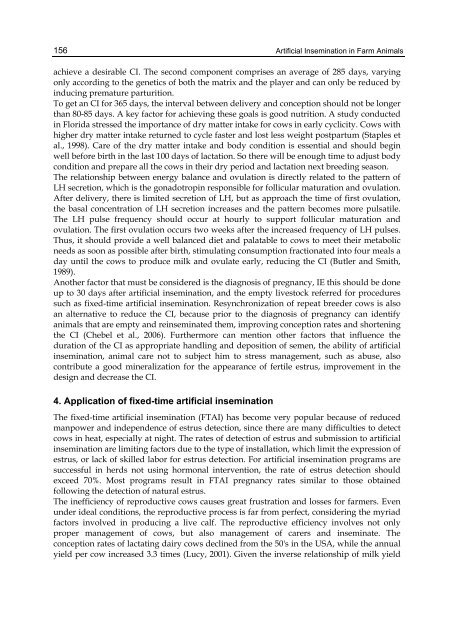ARTIFICIAL INSEMINATION IN FARM ANIMALS - Phenix-Vet
ARTIFICIAL INSEMINATION IN FARM ANIMALS - Phenix-Vet
ARTIFICIAL INSEMINATION IN FARM ANIMALS - Phenix-Vet
Create successful ePaper yourself
Turn your PDF publications into a flip-book with our unique Google optimized e-Paper software.
156Artificial Insemination in Farm Animalsachieve a desirable CI. The second component comprises an average of 285 days, varyingonly according to the genetics of both the matrix and the player and can only be reduced byinducing premature parturition.To get an CI for 365 days, the interval between delivery and conception should not be longerthan 80-85 days. A key factor for achieving these goals is good nutrition. A study conductedin Florida stressed the importance of dry matter intake for cows in early cyclicity. Cows withhigher dry matter intake returned to cycle faster and lost less weight postpartum (Staples etal., 1998). Care of the dry matter intake and body condition is essential and should beginwell before birth in the last 100 days of lactation. So there will be enough time to adjust bodycondition and prepare all the cows in their dry period and lactation next breeding season.The relationship between energy balance and ovulation is directly related to the pattern ofLH secretion, which is the gonadotropin responsible for follicular maturation and ovulation.After delivery, there is limited secretion of LH, but as approach the time of first ovulation,the basal concentration of LH secretion increases and the pattern becomes more pulsatile.The LH pulse frequency should occur at hourly to support follicular maturation andovulation. The first ovulation occurs two weeks after the increased frequency of LH pulses.Thus, it should provide a well balanced diet and palatable to cows to meet their metabolicneeds as soon as possible after birth, stimulating consumption fractionated into four meals aday until the cows to produce milk and ovulate early, reducing the CI (Butler and Smith,1989).Another factor that must be considered is the diagnosis of pregnancy, IE this should be doneup to 30 days after artificial insemination, and the empty livestock referred for proceduressuch as fixed-time artificial insemination. Resynchronization of repeat breeder cows is alsoan alternative to reduce the CI, because prior to the diagnosis of pregnancy can identifyanimals that are empty and reinseminated them, improving conception rates and shorteningthe CI (Chebel et al., 2006). Furthermore can mention other factors that influence theduration of the CI as appropriate handling and deposition of semen, the ability of artificialinsemination, animal care not to subject him to stress management, such as abuse, alsocontribute a good mineralization for the appearance of fertile estrus, improvement in thedesign and decrease the CI.4. Application of fixed-time artificial inseminationThe fixed-time artificial insemination (FTAI) has become very popular because of reducedmanpower and independence of estrus detection, since there are many difficulties to detectcows in heat, especially at night. The rates of detection of estrus and submission to artificialinsemination are limiting factors due to the type of installation, which limit the expression ofestrus, or lack of skilled labor for estrus detection. For artificial insemination programs aresuccessful in herds not using hormonal intervention, the rate of estrus detection shouldexceed 70%. Most programs result in FTAI pregnancy rates similar to those obtainedfollowing the detection of natural estrus.The inefficiency of reproductive cows causes great frustration and losses for farmers. Evenunder ideal conditions, the reproductive process is far from perfect, considering the myriadfactors involved in producing a live calf. The reproductive efficiency involves not onlyproper management of cows, but also management of carers and inseminate. Theconception rates of lactating dairy cows declined from the 50's in the USA, while the annualyield per cow increased 3.3 times (Lucy, 2001). Given the inverse relationship of milk yield










